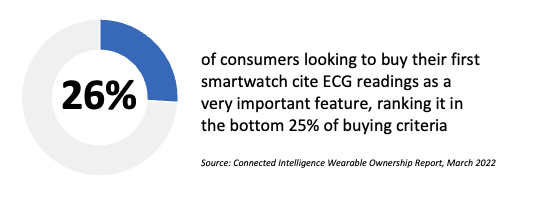
Fitbit goes for the heart
Fitbit has received FDA approval to monitor heart rhythms in a passive, background manner. The new algorithm can track the wearer’s heart rhythm while they are asleep, or awake but not moving. This expands Fitbit’s wellness tracking beyond the previous ECG tracking, which required customers to run the tests manually. As indications of AFib (atrial fibrillation) are typically sporadic, a manual approach was of little value for an ongoing wellness focus.
The NPD Take:
- Fitbit does particularly well among smartwatch intenders who are focused on health as a primary goal, rather than fitness or more communication-driven interest. Adding passive heart rate monitoring further deepens the company’s commitment to the wellness category and can, potentially, help drive subscriptions for Fitbit Premium subscriptions.
Apple goes for body
There are plenty of rumors about what Apple could add to its Watch series this time around but one of the more interesting possibilities comes from Bloomberg. The publication believes that Apple will add body temperature tracking to the Series 8. That is a key feature, as body temperature can be used as an early indicator of illness, such as Covid. But… strangely, the initial rumor suggests that the core focus of the body temperature tracking is to help wearers with fertility planning. Apple is also expected to build on its AFib monitoring, with a new “burden” feature that detects how often a person is in a state of AFib.
The NPD Take:
- Body temperature tracking is a key feature as it can help detect illnesses. Indeed, this was a key differentiator for the Oura Ring, especially in the early days of the pandemic. As such, it’s a strong value add for any smartwatch… assuming it is a passive, ongoing solution.
- We do have a caveat, however. In general, we remain unconvinced about the addition of deeper health/wellness features (AFib for example) as we do not see such features resonating with the majority of smartwatch intenders.
Meta goes for the eye
According to anonymous sources cited in The Verge, Meta plans to launch its first Augmented Reality glasses in 2024, with a second model coming in 2026 and 2028. According to the report, the initial model will be independent of your phone, but will need a “phone-shaped device” to provide the computing power and a wristband for control. According to the rumors, this first variant will off 3D visuals, eye tracking, a camera and speakers.
The NPD Take:
- The “phone-shaped device” is intriguing for a couple of reasons. Firstly, it suggests that Meta is trying to pull us aware from the smartphone-first that we are so used to (smart move since Meta has no play there) and second, that possibly a smartphone simply doesn’t have the raw power – or battery life perhaps – to make this a viable option (at least for the first version). Either way, presumably this device will need a cellular connection, which will make the device appealing to carriers.